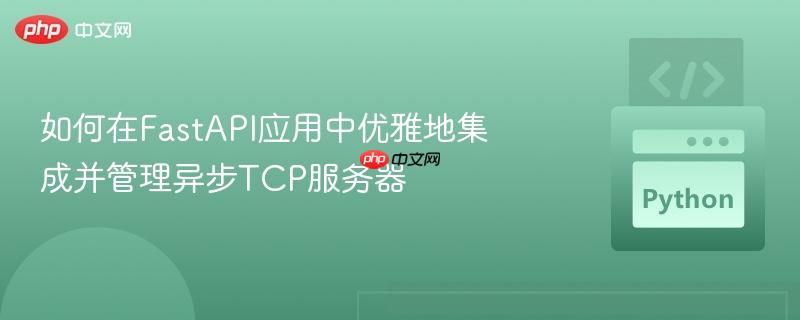
本文详细探讨了在FastAPI应用中,通过`lifespan`事件管理异步TCP服务器的正确方法。核心内容包括识别`lifespan`中`yield`关键字的关键作用,阐明了在应用启动阶段启动TCP服务器任务的必要性,并提供了如何创建、运行及优雅关闭这些异步TCP服务器任务的完整示例代码和专业指导,确保FastAPI与TCP服务能协同工作。
在构建现代Web服务时,有时我们需要将HTTP/WebSocket服务(如FastAPI)与底层协议服务(如TCP服务器)结合起来。本文将深入探讨如何在同一个FastAPI应用中,利用其异步特性和生命周期管理机制,优雅地启动、运行并关闭多个异步TCP服务器。
FastAPI提供了lifespan事件管理功能,允许我们在应用启动(startup)和关闭(shutdown)时执行特定的异步任务。这通过contextlib.asynccontextmanager装饰器实现。其核心是yield关键字,它将lifespan函数分为两个阶段:
常见错误与原因分析:
在初始尝试中,如果将启动TCP服务器的代码放在yield之后,这些TCP服务器将不会在FastAPI应用启动时运行,而只会在应用尝试关闭时才被触发,这显然不符合预期。这就是为什么在应用启动后,TCP服务器的socket连接会失败的原因。
要确保TCP服务器在FastAPI应用启动时同步运行,我们需要将启动逻辑放在yield关键字之前。同时,由于TCP服务器是长时间运行的服务,我们不能直接await它,否则会阻塞FastAPI的启动。正确的做法是使用asyncio.create_task将其作为后台任务运行。
以下是实现这一目标的详细步骤和代码示例。
为了在TCP服务器和WebSocket服务之间共享数据和连接,我们通常需要一个全局状态管理器。
globals.py:
import threading
from websocket_manager import WebSocketManager
# 存储共享数据
data_storage = {}
# 用于数据访问的线程锁
data_lock = threading.Lock()
# WebSocket连接管理器
websocket_manager = WebSocketManager()这个管理器负责处理WebSocket连接的建立、断开和数据广播。
websocket_manager.py:
from fastapi import WebSocket
from typing import List
class WebSocketManager:
def __init__(self):
self.active_connections: List[WebSocket] = []
async def connect(self, websocket: WebSocket):
"""建立WebSocket连接并添加到活动连接列表"""
await websocket.accept()
self.active_connections.append(websocket)
print(f"WebSocket connected: {websocket.client}")
def disconnect(self, websocket: WebSocket):
"""断开WebSocket连接并从活动连接列表移除"""
if websocket in self.active_connections:
self.active_connections.remove(websocket)
print(f"WebSocket disconnected: {websocket.client}")
async def broadcast(self, data: str):
"""向所有活动WebSocket连接广播数据"""
for connection in self.active_connections:
try:
await connection.send_text(data)
except Exception as e:
print(f"Error broadcasting to WebSocket {connection.client}: {e}")
# 如果发送失败,可以考虑断开该连接
self.disconnect(connection)TCP服务器需要处理客户端连接,接收数据,并通过WebSocket管理器广播出去。为了实现优雅关闭,我们将TCP服务器的创建和运行逻辑进行调整,以便lifespan可以管理其生命周期。
server.py:
import asyncio
import globals
async def handle_client(reader: asyncio.StreamReader, writer: asyncio.StreamWriter):
"""处理单个TCP客户端连接"""
addr = writer.get_extra_info('peername')
print(f"TCP client connected from {addr}")
try:
while True:
data = await reader.read(1024) # 读取数据
if not data:
break # 客户端断开连接
decoded_data = data.decode('utf-8', errors='ignore')
print(f"Received from TCP {addr}: {decoded_data}")
# 通过WebSocket广播接收到的数据
await globals.websocket_manager.broadcast(decoded_data)
except asyncio.CancelledError:
print(f"TCP client handler for {addr} cancelled.")
except Exception as e:
print(f"Error handling TCP client {addr}: {e}")
finally:
writer.close()
await writer.wait_closed()
print(f"TCP client {addr} disconnected.")
async def create_and_run_tcp_server(port: int):
"""
创建并运行一个TCP服务器。
此函数返回一个asyncio.Server实例,
其serve_forever()方法将作为后台任务运行。
"""
print(f"Attempting to start TCP server on port {port}...")
server = await asyncio.start_server(handle_client, '0.0.0.0', port)
print(f"TCP server started on port {port}")
# serve_forever()是一个阻塞调用,需要通过create_task在后台运行
# 并且在需要关闭时,调用server.close()来停止它
await server.serve_forever()
return server # 实际上,serve_forever会一直运行,直到被关闭,所以这里通常不会返回这是核心部分,我们将在main.py中定义FastAPI应用,并使用@asynccontextmanager来管理TCP服务器的生命周期。
main.py:
from fastapi import FastAPI, WebSocket, WebSocketDisconnect
import asyncio
import globals
from server import create_and_run_tcp_server # 导入TCP服务器创建函数
from contextlib import asynccontextmanager
# 用于存储TCP服务器实例和其运行任务,以便在应用关闭时进行管理
tcp_servers = []
tcp_server_tasks = []
@asynccontextmanager
async def startup_event(app: FastAPI):
"""
FastAPI应用的生命周期管理器。
在yield之前启动所有后台服务,在yield之后处理服务关闭。
"""
print("--- FastAPI Application Startup ---")
ports = [8001, 8002, 8003] # 定义需要启动的TCP服务器端口
# 启动TCP服务器
print(f"Starting TCP servers on ports: {ports}")
for port in ports:
# 创建TCP服务器实例
server_instance = await asyncio.start_server(globals.handle_client, '0.0.0.0', port)
tcp_servers.append(server_instance)
# 将服务器的serve_forever方法作为后台任务运行
task = asyncio.create_task(server_instance.serve_forever())
tcp_server_tasks.append(task)
print(f"TCP server task created for port {port}")
# 应用启动完成,现在可以处理请求
yield
# 应用关闭阶段:停止所有TCP服务器
print("--- FastAPI Application Shutdown ---")
print("Stopping TCP servers...")
for server_instance in tcp_servers:
server_instance.close() # 向TCP服务器发送关闭信号
# 等待所有TCP服务器任务完成关闭
# return_exceptions=True 确保即使某个任务关闭失败,其他任务也能继续等待
await asyncio.gather(*tcp_server_tasks, return_exceptions=True)
print("All TCP servers stopped gracefully.")
print("--- FastAPI Application Shutdown Complete ---")
# 创建FastAPI应用实例,并指定lifespan管理器
app = FastAPI(lifespan=startup_event)
@app.websocket("/ws")
async def websocket_endpoint(websocket: WebSocket):
"""
FastAPI的WebSocket端点,用于客户端连接。
"""
print("Attempting to connect to WebSocket...")
await globals.websocket_manager.connect(websocket)
print(f"WebSocket connected: {websocket.client}")
try:
while True:
# 保持WebSocket连接活跃,并处理可能接收到的消息
# 这里我们只是接收,不处理,因为数据流是从TCP到WebSocket
message = await websocket.receive_text()
print(f"Received from WebSocket {websocket.client}: {message}")
# 如果需要,可以将WebSocket接收到的数据转发给TCP服务器
# await some_tcp_client_writer.write(message.encode())
except WebSocketDisconnect:
print(f"WebSocket {websocket.client} disconnected.")
except Exception as e:
print(f"WebSocket Error for {websocket.client}: {e}")
finally:
globals.websocket_manager.disconnect(websocket)使用Uvicorn运行FastAPI应用:
uvicorn main:app --reload
当Uvicorn启动时,你将看到FastAPI和TCP服务器的启动日志。TCP服务器将监听在指定的端口(8001, 8002, 8003),并准备接收数据。当客户端连接到TCP服务器并发送数据时,数据将被转发到所有连接的WebSocket客户端。
通过正确利用FastAPI的lifespan事件管理器和Python的asyncio库,我们可以无缝地将异步TCP服务器集成到FastAPI应用中。关键在于理解yield在lifespan中的作用,以及如何使用asyncio.create_task来启动后台任务,并实现优雅的关闭机制。这种集成方式为构建高性能、多协议的现代应用提供了强大的基础。
以上就是如何在FastAPI应用中优雅地集成并管理异步TCP服务器的详细内容,更多请关注php中文网其它相关文章!

每个人都需要一台速度更快、更稳定的 PC。随着时间的推移,垃圾文件、旧注册表数据和不必要的后台进程会占用资源并降低性能。幸运的是,许多工具可以让 Windows 保持平稳运行。

Copyright 2014-2025 https://www.php.cn/ All Rights Reserved | php.cn | 湘ICP备2023035733号